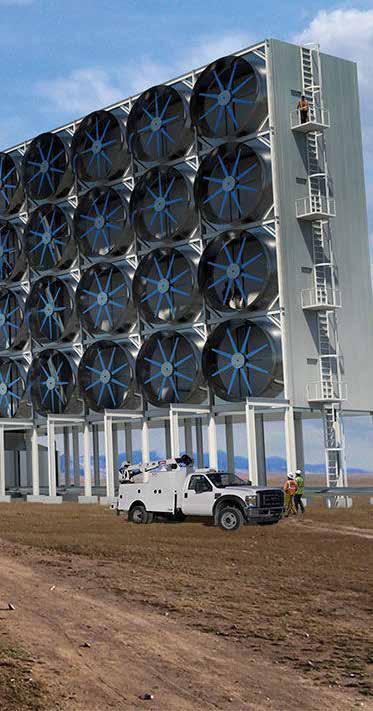
3 minute read
Carbon Capture, Utilization and Storage
by KAUST
Image by Climeworks
Technologies enabling the capture, storage and use of carbon are central to the implementation of the circular carbon economy
Advertisement

CARBON CAPTURE KAUST researchers are developing new materials to enhance carbon capture technology. These materials, known as metal-organic frameworks (MOFs), have significant potential to bring about energy-efficient and cost-effective carbon capture solutions. MOFs are nanoporous compounds with distinct physical characteristics such as high porosity and a large surface area that enable them to capture and contain gases, including CO2.

KAUST’s Functional Materials Design, Discovery and Development (FMD3) research group, headed by Professor Mohamed Eddaoudi, is leading the university’s research in this area. The group focuses on developing next-generation MOF adsorbents that address various energy-intensive separations, including carbon capture from dilute streams such as natural gas combined-cycle power plants and direct air capture. In 2016, FMD3 researchers published an article detailing their construction of a new MOF called KAUST-7, which captured CO2 from air in larger quantities and more efficiently than existing alternatives. This MOF can reduce emissions from two major sources of carbon pollution: stationary power plants and transportation. In September 2019, Professor Eddaoudi received the Abdul Hameed Shoman Prize for Arab Researchers in recognition of his and KAUST’s accomplishments in using MOFs to address environmental and energy challenges. “Aramco is making significant research investments with Professor Eddaoudi’s group at KAUST in developing next-generation CO2 capture materials. If successful, this will pave the way for a costeffective, first-of-a-kind MOF-based CO2 capture system emerging from a unique industry-university collaboration between Aramco and KAUST.”
Aqil Jamal, Chief Technologist of Saudi Aramco’s Carbon Management Research Division
In addition to developing technologies to capture airborne carbon, KAUST researchers have discovered that macro-algae, or seaweed, naturally captures more carbon from the atmosphere than previously thought. Plants such as seaweed and trees capture atmospheric carbon through carbon sequestration, and they convert the sequestered carbon into plant material. In August 2019, a group of international researchers led by KAUST Professor Carlos Duarte announced the first documented quantitative evidence locating seaweed beyond the shoreline. They discovered that a varied set of macro-algae species drift up to 5,000 kilometers beyond coastal areas. About 70% of this macro-algae – and the carbon captured by it – sinks to depths of up to 1,000 meters below sea level. At these depths, the sequestered carbon is unlikely to resurface and return to the atmosphere. While KAUST researchers are still determining how much carbon is captured by the identified seaweed, their discovery is paving the way to incorporate seaweed-captured carbon into global calculations of blue carbon, which accumulate in the ocean. An accurate assessment of blue carbon is the first step in protecting and restoring coastal ecosystems that sequester carbon. The government of Catalonia awarded Professor Duarte the Ramon Margalef Prize in Ecology in July 2019 for his and KAUST’s research on blue carbon.
CARBON STORAGE Since February 2017, KAUST’s Petroleum Engineering Research Center has been a key member in a project dedicated to assessing the feasibility of storing carbon in Saudi Arabia. The project’s research team, which includes KAUST Associate Professor Hussein Hoteit and KAUST graduate Ali Hamieh, is currently assessing the potential of storing carbon at a site in Harrat Khaybar, a volcanic field near Saudi Aramco’s Yanbu refinery. Completing the feasibility study at Harrat Khaybar is one of the team’s larger objectives, which also include establishing a Saudi Arabia-wide inventory of potential carbon storage sites near carbon emission sources. KAUST researchers have already created a database of Saudi Arabia’s major stationary sources of carbon. These sources include facilities associated with the Kingdom’s electricity, desalination, refining, cement, petrochemical and metals activities. Others involved in this project are the Ministry of Economy and Planning, and Dr. Mohammed Moufti from King Abdulaziz University.
CARBON UTILIZATION The KAUST Catalysis Center, led by Professor Jorge Gascon, is developing methods to convert captured CO2 into industrial chemical feedstock. For example, in April 2019 KAUST researchers published a paper detailing their development of a catalyst that can convert CO2 into olefins, which are used to make plastics and fibers. Traditional methods of manufacturing olefins rely on synthesis gas, a mixture composed primarily of hydrogen and carbon monoxide. KAUST researchers demonstrated that the catalytic process using CO2 can be as productive as traditional methods, but that it also has the economic and environmental advantage of monetizing captured carbon.









